Mutton with Apricots
Jardaloo Boti (Bombay)
Mutton or chicken with apricots is a popular Parsee dish, and the Persian influence shows because it is the Hunza or Afghani apricots that are used. These are the best ones to use. This is quite a simple dish to prepare, and has a tinge of sweet and sour. It is best with a yellow-coloured rice but can also eaten just with side vegetables, as in Western cuisine.
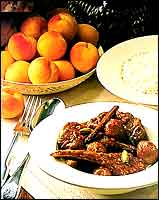 Ingredients:
Ingredients:
100 gm dried apricots
(jardaloo)
1/4 cup oil
2 onions, very finely chopped
1/2 inch square piece of fresh ginger, chopped
4 plump garlic cloves, finely chopped
3-inch cinnamon stick
6 green cardamoms
1 1/2 tsps red chilli powder
2 tsp cumin powder
2 tomatoes, chopped
750 stewing mutton or boti
3/4 tsp garam masala powder
1/4 tsp ground black pepper
salt 3/4 tsp, a few drops of vinegar
1 tsp sugar
Procedure:
Soak the apricots in 1 cup water with a few drops of vinegar added, for 3 hours. Heat the oil in a cooking pot and fry the onions for about 10 minutes until golden-brown. Add the ginger and garlic. After 3 minutes add the cinnamon and cardmoms. After a further minute add the chilli and cumin poweders, and stir well. After a few seconds add the tomatoes and cook for 5 minutes. Then add the meat, garam masala powder and pepper and stir-fry in the spices for about 5 minutes. Add salt to taste, then cook slowly over a very low heat until tender. if all the liquid evaporates, add 1/2 cup water. When the meat is done, add 3/4 tsp vinegar, the sugar and the drained apricots, and cook for a few minutes, mixing well. It is now ready to serve.
Chicken Stew
Kerala
The word 'stew' has become part of the Indian culinary vocabulary. In Southern India, stew is made with coconut milk and Malabar coast spices. In Kerala in particular it is commonly eaten with appams or rice flour pancakes for breakfast or Sunday brunch. In Northern India, even roadside eateries serve a mild curry which they call stew. The dish can be made milder still by reducing the green chilli. But it is really aromatic. A lady from Kerala says that she thinks the combination of ghee and oil imparts a special flavour. The Keralites use very tiny pieces of chicken on the bone. But you can use small boneless pieces too. On the bone, this quantity will serve 4, but boneless should suffice for 5. Serves 4-5
Ingredients:
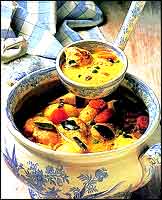 2 medium onions
2 medium onions
1 x 3/4-inch piece
of fresh ginger (half cut into thin julienne, the other half into pieces)
1 tsp peppercorns a little turmeric powder
2 onions, chopped coarsely
2-3 green chillies
2 cups grated fresh coconut or 1 1/2 cups tinned coconut milk
10-12 new potatoes
salt, to taste, 2 tbsps oil
1 tbsp ghee
1/2 tsp mustard seeds
1 cinnamon or bay leaf
2 garlc cloves, sliced lengthwise
2-inch cinnamon stick
4 cardamoms
3 cloves
20 curry leaves
800 gm boneless, skinless chicken pieces
1 carrot, peeled and cut into 3/4-inch strips
1/2 cup fresh or frozen peas
1/4 tsp garam masala powder
Procedure:
Pound the ginger pieces (retain the julienne strips for later), peppercorns and a little turmeric into a thick uneven paste. Blend together the onions and green chillies. Put the grated coconut into 2 cups water and blend to make an extract. Strain and keep to one side. Scrub the potatoes and half-boil them in their skin with a pinch of salt and turmeric. Heat the oil and ghee, and when hot add the mustard seeds. When the seeds crackle, add the cinnamon or bayleaf. When the leaf turns a khaki colour add the sliced garlic, the cinnamon stick and cardamoms. After 20 seconds add the ginger paste, cloves and curry leaves, then add the chicken and saute in the spiced oil for 2-3 minutes. Salt to taste, then add the potatoes and carrot and cook, covered, for 2 minutes. Finally add the cocount milk; half a cup of water, the peas and juliennes of ginger. Sprinkle with garam masala powder and cook covered till the chicken is done.
Goan Pork Vindaloo
Goa
Vindaloo is a dish made by descendants of, or those who lived in areas dominated by, the Portuguese. It is primarily made with chillies, garam masalam, garlic and vinegar. The word vindaloo comes from a combination of vin for vinegar and aloo from albo, which is Portuguese for garlic. The chillies were introduced into Goa by the Portuguese, and the garam masala spices were those traded in the sixteenth and seventeenth centuries. This is one of the best vindaloo recipes. You can make it as hot as you want. Phil Mendes from Goa whose recipe it is, likes her food spicy but not searing hot and therefore she de-seeds the red chillies. Vindaloo in Goa was and is traditionally made with pork. But you can also make it with mutton. Best with boiled rice. Serves 5-6
Ingredients:
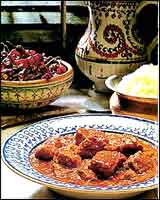 15-20 whole red chillies (preferably Kashmiri type) or 3-1/2 tsps red chilli powder
15-20 whole red chillies (preferably Kashmiri type) or 3-1/2 tsps red chilli powder
1 tsp cumin seeds
6 cloves
2-inch cinnamon stick
10 peppercorns
1-4 star anise
1 tsp poppy seeds
2 x 1/4-inch piece of ginger
6 plump garlic cloves
1 tbsp tamarind pulp
4 tsps Goa or Parsee vinegar
1/3 cup oil
3 medium onions, finely chopped
750 gm pork or mutton, cubed salt
1/2 tsp jaggery to taste
15 curry leaves
Procedure:
Soak the chillies in a little water to soften. Then grind all the spices including the chillies, ginger, garlic and tamarind with the vinegar to make a smooth paste. Rub a little of the spice mixture on to the meat and marinate for 1 hour. Heat the oil in a cooking pot and fry the onions for about 15 minutes until brown. Add the spice paste and fry for a further 5 minutes, stirring continuously and adding 2 tbsps water if neccessary. Add the meat and saute in the spice mixture for 5 minutes. Add 4 cups water and salt to taste and cook over a low heat until tender. Stir in the curry leaves and simmer for 3-4 minutes; the vindaloo is now ready to serve. The vinegar and oil in the dish act as preservatives and it freezes extremely well. It can also keep in the refrigerator for 2 days and will in fact be better the day after cooking. You can also make just the spice paste in large batches and freeze it, using small amounts as and when required.This dish is equally good using beef.
Fish in Mustard Gravy
Sorso Bhaate Maach
Bengal
Mustard is the favourite spice of Bengal, where both mustard oil and mustard seeds are used in many dishes. This is the dish-celebre of Bengali cuisine, and the preferred fish is the boney hilsa. The traditional recipes impart a rather strong flavour and I think the dish improves with the inclusion of tomato and a little lime juice. You can use the fish of your choice, such as cod. This dish is traditionally eaten with boiled rice. Serves 4
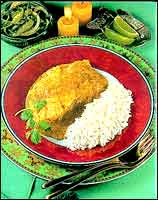 Ingredients:
Ingredients:
600 gm pieces of fish
1 3/4 tsp salt
2 tbsps poppy seeds
2 tbsps brown mustard seeds
1 tsp turmeric powder
1/4 fresh coconut, diced (50 gm)
1x3/4-inch piece of ginger
6 garlic cloves
2-3 green chillies
1 onion, coarsely chopped
2 tsps coriander powder
2 tsps cumin powder
1-1 1/2 tsps red chilli powder
5 tbsps oil
3 tomatoes, pureed
juice of 1/2 lime
2 tbsps coriander leaves
Procedure:
Wash the fish pieces thoroughly. Smear each piece with a little salt and leave for half an hour. Wash off. Toast the poppy seeds for 2 minutes on a griddle on low heat. Then soak in little water for 15 minutes and pound in a mortar and pestle. Grind together the crushed poppy seeds, the mustard seeds, turmeric, coconut, ginger, garlic, green chillies, onion, coriander, cumin, red chilli powder and 1 1/4 tsp salt, along with 1/2 cup water, to make a paste. In a large frying pan heat the oil over a moderate heat and fry the spice paste for 6-7 minutes, stirring continuously and adding a little water at a time (up to 1/2 cup) as and when required. Add the tomatoes and saute for 5 minutes adding 2 to 3 tbsps water if required. Then pour in 2 cups water and the lime juice and simmer for 5 minutes on a low heat. Salt to taste. Add the fish pieces and cook until done. Sprinkle with fresh coriander leaves when serving.
Mixed Dried Fruit Curry
Dry Fruit Korma (Bombay)
The Taj Mahal Hotel in Bombay has a magnificent ballroom where for several decades a lavish lunch used to be served every day, against a backdrop of a live orchestra. As life moved on from the age of leisure to one of practicality, the daily buffet lunch died a natural death in the late 1980s. The buffet used to have separate section for vegetarian food, both Indian and Western. Occasionally a version of this curry used to feature in it. It is one of my favourites. I have adapted the recipe to make it more full-bodied although it is still mild. This is an ideal dish to serve from an important occasion when you want to prepare a vegetarian curry meal or as a side dish, in which case reduce the amount of water added towards the end. As a main course, serve with yellow or saffron rice.
Serves 4-5
Ingredients:
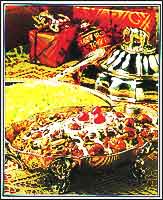 100 gm dried Afghan a pricots
100 gm dried Afghan a pricots
100 gm almonds, blanched
75 gm pistachios
100 gm cashew nuts
1 1/2 cups full-fat yoghurt
salt
1/2 tsp ground white pepper
4 tbsps oil
1 cinnamon leaf (tej patta)
2-inch cinnamon stick
3 cloves
3 onions, finely chopped
1x1/2-inch piece of fresh ginger, chopped
4 garlic cloves, chopped
4 green chillies, chopped
1 tsp coriander powder
1 tsp cumin powder
1 tsp red chilli powder
2 tomatoes, chopped
3 tbsps ghee
75 gm walnut pieces
100 gm seedless yellow raisins
1/4 tsp garam masala powder
3 tbsps single cream
a few maraschino cherries, to garnish
Procedure:
Soak the apricots in water for 1 1/2 hours, then slit and remove the stones (if unpitted). Soak the almonds and pistachios in hot water for 1 hour. Remove the skins. Reserve the soakinng water for use in the curry. Grind half the cashew nuts with a little water to make a paste. Whisk the yoghurt, adding 1/4 tsp salt and the white pepper.
Heat the oil in a frying pan with the cinnamon leaf, cinnamon and cloves. Add the onions and fry until medium-brown. This will take about 15 minutes. Add the ginger, garlic and chillies, and saute for 5 minutes. By now the onions should be dark brown. It is important for the taste and appearance of the dish that the onions should fry to deep brown � almost cafe au lait colour. Add the coriander powder and saute for 3-4 minutes, then add the cumin and red chilli powders, stirring continuously. After a minute add the tomatoes and saute for 2-3 minutes.
Remove from the heat and cool. Remove the cinnamon leaf, put into a blender and puree. Then pour into a cooking pot. Add the whisked yoghurt, cashew paste and 2 cups water, with salt to taste, and simmer, covered, for 15 minutes. Meanwhile, heat the ghee in a frying pan and fry the almonds, cashew nuts, walnut pieces, raisins, apricots and most of the pistachios for 6-7 minutes, reserving a few for the garnish. Add the nuts and fruit
mixture to the gravy and cook, covered, on low heat for 15 minutes.
Sprinkle with garam masala powder and cook for a further 5 minute until the nuts are tender. Garnish with swirls of cream, flaked pistachios and maraschino cherries, just before serving.
Aubergine Curry
Kerala
This is a homestyle curry from Kerala. The traditional way of cooking anything with tamarind is in a terracotta dish, and the terracotta in Kerala is often of the black variety. This curry is hot with a sour tang to it. Very tasty, it is best with a flavoured rice like lemon rice or dill rice, and fried South Indian papadams. Serves 4
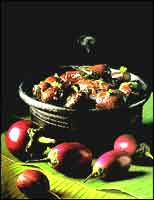 Ingredients:
Ingredients:
40 gm tamarind pulp
500 gm bay aubergines (baingans)
salt
1/2 fresh coconut, grated
6 whole red chillies
1 tsp coriander seeds
1/2 tsp cumin seeds
4 tbsps oil
1/4 tsp mustard seeds
1 tsp chopped garlic
1 tsp fresh ginger, chopped
8-10 curry leaves
400 gm onions, chopped
1/4 tsp turmeric powder
1 tbsp chopped coriander leaves, to garnish
Procedure:
Soak the tamarind in 1/2 cup hot water for at least 30 minutes. Make 2 incisions, like a cross, halfway up each aubergine. Cut off the stems. Soak in water with a pinch of salt for 15 minutes, to reduce the natural bitterness. On a heated griddle toast the coconut for 5-6 minutes, then add the chillies and coriander seeds and toast for 2-3 minutes. Add the cumin and toast for 1 minute. Put into a small grinder and grind to a paste, adding a little water. Heat the oil in a cooking pot and add the mustard seeds. When they crackle, add the garlic, ginger and curry leaves, then the onions and turmeric. After 25 minutes add the spice paste and saute for a further 10-15 minutes, adding a little water if the spices stick. Add 2 cups water, stir well, add salt to taste (about 1-1/4 tsps) and the aubergines and cover with the lid. After 15 minutes add the tamarind water (after squeezing the tamarind and straining it). Cook until the aubergines are tender, then remove from the heat and sprinkle with coriander leaves when serving.
Ladyfingers in Yoghurt
Dahi Kadhi
Gujarat
This curry is actually a cross between a lentil and a curry, made with yoghurt and gram flour (besan) as its main ingredients. It has a delightful taste and is eaten almost every day as part of the thali meal. Its sour-sweet flavour is tinged with a hint of chilli. It is very thin in consistency and ideal to drink as a soup. Serves 6
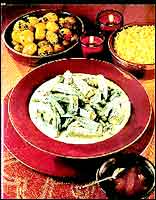 Ingredients:
Ingredients:
2-1/2 cups whole milk yoghurt
5 tbsps gram flour (besan)
2 tsps chopped fresh ginger
1 tsp chopped green chilli
about 20 small ladyfingers (bhindi)
3 tbsps sugar
salt. 2 tbsps ghee or oil
10 cloves
1-1/2 tsps fenugreek seeds
1 tsp cumin seeds
1/4 tsp asafoetida
about 20 curry leaves
Procedure:
Whisk the yoghurt and add the gram flour. Mix well with 4 cups water. Puree the ginger and chilli together. Wash the okra and trim the stems to minimum without cutting into the vegetable. Bring the yoghurt mixture to the boil in a cooking pot. Add the ginger and green chilli puree, the sugar, salt to taste (about 1 tbsp) and okra. Heat the ghee or oil in a ladle and fry the cloves, the fenugreek and cumin seeds, for 30 seconds, then remove from the heat and add the asafoetida. Immediately add the yoghurt mixture with the curry leaves. Cook for a total of 15-20 minutes or until the ladyfingers are tender. Instead of ladyfingers you can use of white radish cut into short pieces.




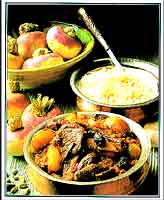 Ingredients:
Ingredients: Ingredients:
Ingredients: 2 medium onions
2 medium onions 15-20 whole red chillies (preferably Kashmiri type) or 3-1/2 tsps red chilli powder
15-20 whole red chillies (preferably Kashmiri type) or 3-1/2 tsps red chilli powder  Ingredients:
Ingredients: 100 gm dried Afghan a pricots
100 gm dried Afghan a pricots  Ingredients:
Ingredients: Ingredients:
Ingredients: